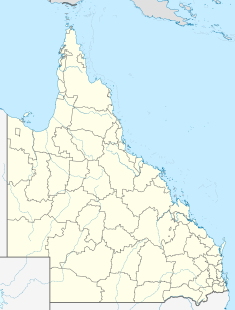Hemmant State School
| Hemmant State School | |
|---|---|

1876 school building
|
|
| Location | 56 Hemmant-Tingalpa Road, Hemmant, City of Brisbane, Queensland, Australia |
| Coordinates | 27°26′52″S 153°07′38″E / 27.4479°S 153.1271°ECoordinates: 27°26′52″S 153°07′38″E / 27.4479°S 153.1271°E |
| Design period | 1870s - 1890s (late 19th century) |
| Built | 1876 - 1930s |
| Architect | Francis Drummond Greville Stanley |
| Official name: Hemmant State School and Dumbarton, Ashcroft House, Gibson House, Bulimba Creek School, Doughboy Creek Mixed School | |
| Type | state heritage (built) |
| Designated | 4 September 2003 |
| Reference no. | 602382 |
| Significant period | 1870s (historical) 1870s-1930s (fabric) 1876-ongoing (social) |
| Significant components | staffroom/s / teachers' room/s / teachers' retiring room/s, residential accommodation - housing, school/school room, play shed |
Hemmant State School is a heritage-listed state school at 56 Hemmant-Tingalpa Road, Hemmant, City of Brisbane, Queensland, Australia. It was built from 1876 to 1930s. Its architects included Francis Drummond Greville Stanley. It is also known as Bulimba Creek School and Doughboy Creek Mixed School. On its grounds is the historic house Dumbarton, also known as Ashcroft House and Gibson House. It was added to the Queensland Heritage Register on 4 September 2003.
Hemmant State School was established in 1864 as the Bulimba Creek School (non-vested). It contains several generations of public works buildings that were built as the community at Hemmant expanded and developed. The oldest remaining building was erected in 1876, to a design by Queensland Colonial Architect, Francis Drummond Greville Stanley. The Playshed was added in 1884. The house known as Dumbarton, which was relocated from another Hemmant location to the school site in 2001, was built probably in the 1870s or early 1880s and local opinion attributes its construction and occupation to the Uhlmann and Gibson families. The Uhlman family was significant in the area as local butchers, milkmen and storekeepers, while the Gilson family were significant in the development of the sugar industry in Queensland.
Hemmant was originally known as Doughboy Creek and the first land sales took place in 1858. Non-indigenous settlement in the area commenced the following year when the Franklin and Popham families migrated in the same ship and took up adjacent pieces of land at Hemmant. English, Scottish, Dutch and German migrants followed and established farms. The soil was easy to clear and fertile, and the first crops were vegetables and fruit, which were transported up the river to Brisbane until the construction of the bridge over Bulimba Creek in 1870 made road transport possible.
In 1863 William Gibson and his son Angus arrived in Moreton Bay and settled at Hemmant. The remainder of the family followed in 1864. In 1866 William Gibson obtained cane cuttings from Louis Hope at Ormiston, which he planted at Hemmant, on a farm he called Clydesdale. Other farmers in the district also switched to sugar production. In 1868 William Gibson and Sons established the Clydesdale Sugar Mill, and by 1871 there were seven mills in the area. In the second half of the 1870s, however, drought and disease destroyed the crops repeatedly and sugar farming was moved further north. In 1883, the Clydesdale Mill was sold and the Gibson family began the move to Bingera at Bundaberg. The mill closed down the following year, and Hemmant returned to vegetable and dairy production.
...
Wikipedia


